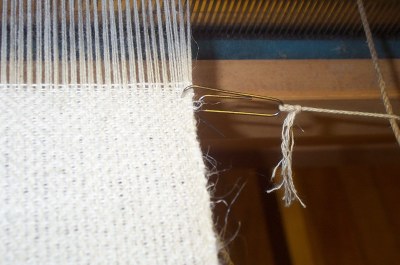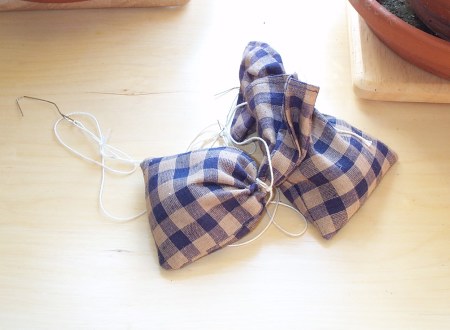| WOOLGATHERERS SIMPLE TEMPLE TO MAKE | |||||
|
|
Using a temple will stretch the web and allow the dents in the reed to beat squarely with more force than if the fabric has drawn in, even just a little. This leads to fabric with a square grain (warp 90 degrees to the weft) - "smileys" where the fell line is curved or wavy will disappear, the temple will allow a slight tug as the weft turns - meaning fewer loops at the edge.
Using a temple will NOT guarantee good selvages, though it should make producing nice ones easier. It will NOT keep fabric from drawing in due to normal weaving takeup - what the weaver is striving for is an even width behind the temple.
Temples come in many forms and have been used for many centuries. They are not something that indicates cheating or lack of weaving skills, but are a proven tool to make a better quality cloth. Actually, they are still used in industrial settings in spite of all the technological advances since the first handlooms.
Here are 3 photos showing how to make a temple that I first saw in a professional weaving shop - several women working full time on large looms making basket-weave woolen cloth with rosepath borders for a line of clothing offered in the museum gift shop. The wool cloth was not terribly heavy, and rather than use the heavier wooden or roller temples, they chose to use something very similar to what is pictured. Since they were just behind the sea dikes, their weights were a mix of metal washers and seashells attached to a hook rather than the large
metal nut that is pictured. (Prettier set is shown at bottom of page - Click here). THE WOOLGATHERERS NOW CARRIES SWEDISH WOODEN TEMPLES - for more information go to our Weaving Accessories page 1 OF A PAIR OF TEMPLES - SIMPLE, YET EFFECTIVE!!!
 You will need 2 of these devices - weights, ca. 1 foot of rug warp per "temple", and "hooks" - anything you'd like, including a bent paper clip.
These hooks are then placed into the cloth at the selvage and stretched out over the sides of the loom. If your loom has high boards on the sides, this will do. If the boards are lower, as pictured, running support cords from breast beam to back beam gives proper support.
Time to make and install - less than 2 hours.
TEMPLES INSTALLED ON THE LOOM - NOTE THAT THE KNOTTED CORD
HANGING DOWN IS THE MEASURING STRING NOT PART OF THE TEMPLE
 Effective? - take a look at the close-up photo showing the beater ca. 1.5 inches from the fell line and no noticeable distortion in the warp threads from draw in. If the weaver is willing to modify the loom, eye bolts can be inserted on the loom uprights to carry the string of the weighted temple. When the string is at too much of an angle, it is time to move them.  One thing I have noticed and come to love using a temple is the beat on the fell line is firm and square, never "mushy". How much weight? That is something that will vary from weaver to weaver - because household items can be added or removed, varying them until they are "just right" takes time, but no cash outlay.
Here I have used two of the little sachet bags I keep on hand for filling with garden lavender and put ca. 4 ounces of rice in each. They don't clank and look "prettier" when in use. I still use the bent paper clips - they are easy to replace, don't tear up the fabric, and they can be reset with only one hand - no release mechanism - just pull out and push in.
Cloth Bags as Temples
Some weavers have an issue with using the simple paper clips as hooks. The professional weavers I have observed using these use similar metal hooks as they are quick and easy to move. Any small holes in the fabric have generally disappeared before the cloth advances to the cloth beam. Using croc, tarp or alligator clips works - BUT to be effective they must hang from the outer edge of the fabric which places them exactly where the hooks will lie. Other materials to use for weights - fishing sinkers, washers on a key ring (weight can be adjusted easily), collections of small objects from the beach, backyard or vacation. |

